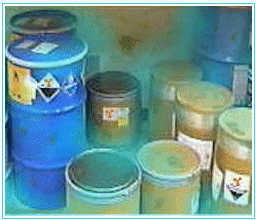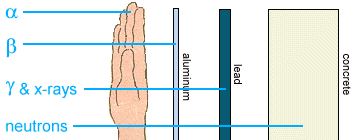 Typical radioactive wastes – e.g., from a research hospital – might include:
Typical radioactive wastes – e.g., from a research hospital – might include: Typical radioactive wastes – e.g., from a research hospital – might include:
Typical radioactive wastes – e.g., from a research hospital – might include:
Producers of radioactive wastes often store isotopes with a half-life of 90 days or less until they have decayed enough for
disposal. For medical wastes, "disposal" means incineration, because
of the possibility of infectious substances.
Some materials decay below background radiation levels in less than 10 half-lives. Others, however, are still quite radioactive after 20 half-lives.
The standard guideline is to store materials for 10 half-lives.
The construction of storage facilities depends on the energy levels of radiation being emitted. For example, 131I is shielded by two feet of solid concrete, which reduces radiation by a factor of 10, but does not completely contain it. In contrast, 32P can be completely shielded with a half-inch of high density polyethylene.

|
|
|
example continues... |
| Back to Contents | ||